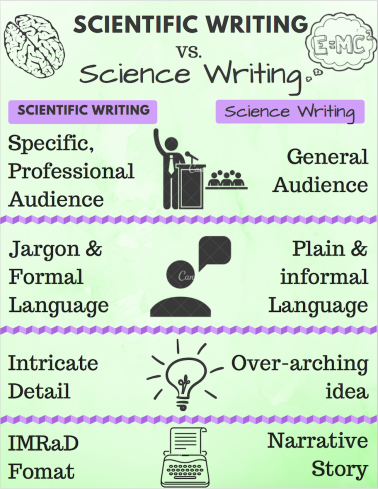


Infographic by Amy Foltz
Science communication can be grouped into two broad categories: scientific writing and science writing. Although these areas may seem similar, they are marked by important distinctions. Scientific writing includes discourse between professional scientists, such as peer-reviewed journal articles. Science writing describes literature used to communicate science to a wider, general audience.
Scientific writing is usually used to communicate research results between experts. The content of this writing is highly technical and as objective as possible. Examples include primary research articles, grant proposals, literature reviews, abstracts, presentations, posters, and letters. Because the audience is specific and professional, the language can include jargon specific to the field.
It is necessary to include great detail in this writing, since it serves as an official record of research. Much of this communication is also subject to the process of peer review. The structure of scientific writing often follows an IMRAD format, which includes sections for the introduction, methods, results, and discussion.
On the other hand, science writing communicates discoveries to a broader audience. This includes a greater diversity of content, as a communicator could focus on a particular finding, an explanation for an item of public interest, a researcher spotlight, or a debate in the field. Science writing includes articles, interviews, videos, social media, and podcasts about science. The audience for science writing could be general laypeople or a more specific readership. Because these readers are less knowledgeable in a particular field, technical jargon should be avoided. Often, metaphors and analogies are included to explain a concept. It is more important to convey the important ideas of the research than it is to belabor each detail. Narrative form is important in this communication; coalescing science ideas into a story makes them communicable to the public.